When India was decolonised and granted independence, one of its significant early acts was to write its own constitution. This was a remarkable, somewhat unusual achievement among former British colonies. Many others often had their constitutions written for them by the British (like Sri Lanka) or enacted failed attempts to compose a constitution themselves (like Pakistan)1. I begin with the Indian constitution, not so much for the document itself, but for what it has been made to represent in different contexts.
Originally, the Constituent Assembly charged with crafting Independent India’s constitution was a notably elite enterprise. Of the roughly three hundred people involved, most were upper caste and upper-class men2. These men wrote independent India’s guiding civic document in, literally, a wood-paneled room whose design was intended to mark that space as extraordinary in the literal sense of the term. In this set-apart space, the constitution was projected as the foundation of modern India, a sharp contrast to how we have seen it interpreted in recent months.

Over the last several months, India has been rocked by widespread protests that seek to pushback against the BJP’s set of bigoted laws and policies– the Citizenship Amendment Act (CAA), the National Register of Citizens (NRC) and the National Population Register (NPR). These three policies are designed, when working together, to strip many Indian Muslims of citizenship. In many of the protests, the Indian constitution has become a rallying symbol.
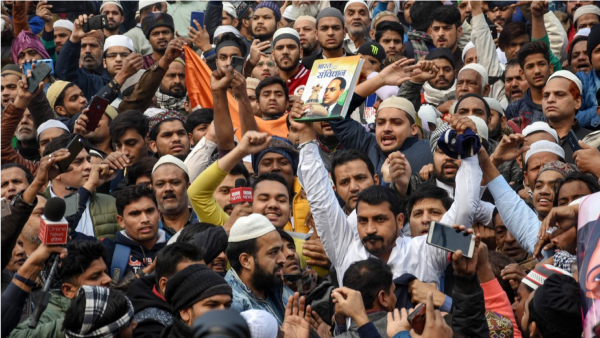
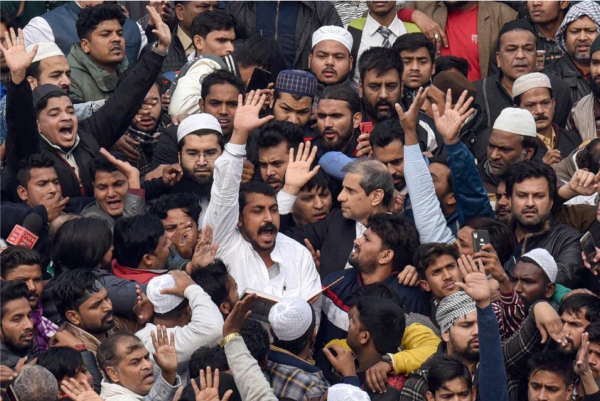
In the first photo above, for example, taken on December 20, 2019, you can see Chandrashekhar Azad, a dalit leader, raising the constitution into the sky almost as if it has talismanic power, an image enhanced by the motion and energy of the crowd that spill beyond the camera’s frame. The next photo shows Chandrashekhar reading from the constitution in the midst of the swirling crowd. Chandrashekhar is hardly the only Indian heavily invested in the constitution during the CAA controversy. The document has appeared regularly at protests across India and elsewhere. Drawing from my own life, for instance, I attended a solidarity protest at Rutgers-New Brunswick a few weeks ago (in early February 2020), and, like protestors across the globe, I received a copy of the Indian constitution’s preamble, which we read aloud together3. In my case, the preamble was copied, appropriately given the educational context, from an NCERT textbook. It now lives on my office door, its crumpled form a testament to the chilling rain on the day of the protest.
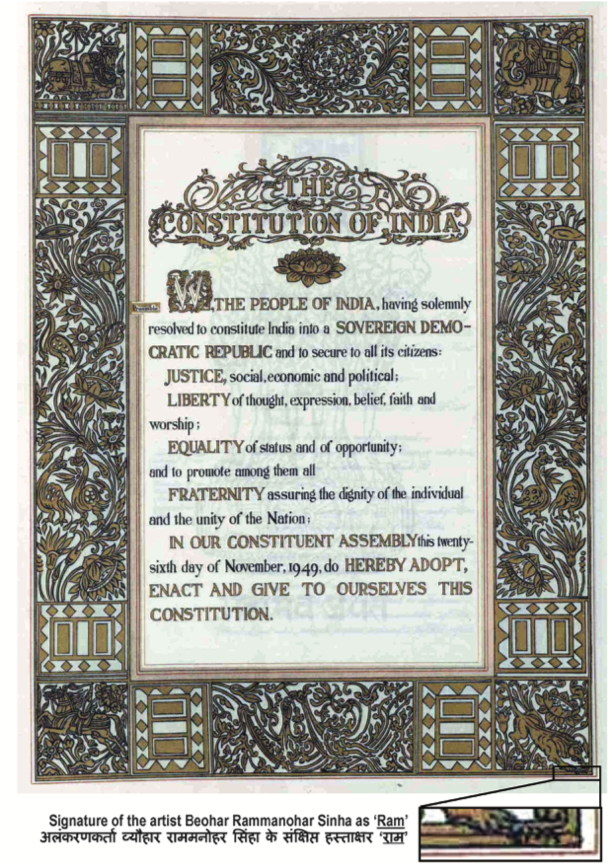
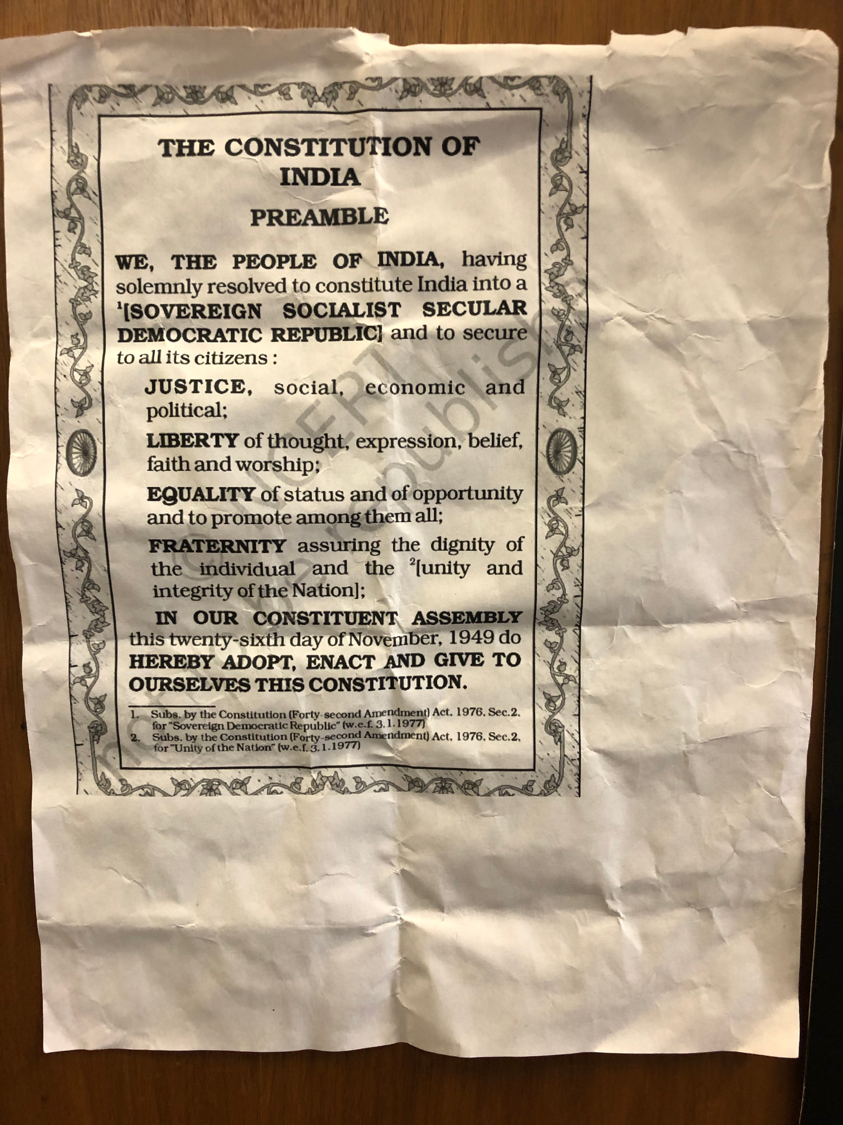
As compared to the formal rooms in which the Indian constitution was composed, its context has changed quite radically. Now it is a document living in the gritty, pedestrian, unpredictable streets. There is no doubt that the Indian constitution has become—in this moment—a “symbol of substance,” to borrow a phrase4. But what is that substance?
Chandrashekhar Azad and many other Indian citizens continue to see the constitution as foundational to the Indian state, but one notable entity disagrees at least in some contexts: the state itself. The day after these photos were taken, Delhi police arrested Chandrashekhar on the charge that he held a protest without permission5. In other words, they arrested him for reading the Indian constitution to a large group of people on the streets. He remained in police custody for weeks and was denied medical care, endangering his life to the extent that, in early January of 2020, a Delhi court ordered Tihar jail to provide Chandrashekhar with medical treatment to prevent cardiac arrest6. Among other things, context was crucial in changing the perceived meaning of India’s constitution, from an elite document the served as the cornerstone of the nation state to a symbol of resistance, so threatening to state interests that it seemed, to some, better to risk the life of a prominent Indian citizen rather than allow him to read it.
As the constitution has been made to embody highly contesting meanings in India’s anti-CAA protests, it has prompted me to reflect on how the meaning of the past changes depending on where, how, and why one invokes it. In fact, history changes—meaning, as history, not the mundane facts of the past but rather our narrative thereof—in each retelling. That is all good and well in here, in academic spaces that are, to borrow Dipesh Chakrabarty’s term, cloistered7. Within the ivory tower, we all play, more or less, by the rules of historical method and academic integrity. But history is largely woven into a coherent narrative far beyond these walls, in other much more public and more dangerous domains.
Most academics would readily admit, as a fact of life, that the past is debated, discussed, imagined, and projected in spheres beyond academia. But let me make two further, perhaps more controversial points. One, the scholarly world is not the most important loci for the production of history. If we measure by influence, for instance, amateur historians dominate the popular market for history books in the United States and in India. In India, arguably WhatsApp forwards are now the main source of knowledge about the past for most people. In other words, a combination of amateur historians and trolls supply the background against which people read scholarship on Indian history, if they bother to read what trained historians write at all. As Michel-Rolph Trouillot put it a quarter of a century ago, “Professional historians alone do not set the narrative framework into which their stories fit. Most often, someone else has already entered the scene and set the cycle of silences.”8
A second point I wish to make about the non-academic production of history is that we, too, are influenced by it. In this sense, it seems to me that the persistent self-cloistering of academics works only one way, to prevent others from accessing our work. Many scholars go to great lengths to make their research inaccessible. We write books so dense with jargon and high theory that nobody can understand them. We lock our scholarship behind paywalls where few can access our articles. The most common thing a newly-minted PhD student does is to embargo her dissertation so that nobody can read it for years, until the research has become stale. We have pretty effective methods in place to deter other people from being influenced by what we write. But all scholars engage, as consumers, in non-academic loci for the production of history. We all do some of the following – read novels, keep up on the news, go to the theatre, listen to podcasts, show our kids comic books, participate in WhatsApp groups, shake our heads at crazy email forwards from relatives, use Wikipedia, look at Twitter and Facebook, think about what’s grammable, try to figure out TikTok, binge on Netflix, go to protests, and so forth. Sumit Guha recently wrote: “A conceived past informs every lived present–and the present in turn is where historians live and practice.”9 I agree, and I think that perhaps scholars do not always fully appreciate the forces external to the academy that help shape our conceived past and by extension our present.
Given their pervasive importance today, I want to look at some of the non-academic loci for the production of Indian history and analyse the logic of each site. I also want to consider how a historian might intervene or position herself in these various contexts and the sorts of problems she will likely face. At the outset, let me say that I do not consider it self-evident that historians ought to engage beyond the ivory tower. One thing that I have learned in developing a reputation and a practice as a public intellectual over the last several years is that many in the academy neither welcome nor respect that decision. The old-fashioned view is still prevalent that a scholar should contain herself within academia, that she (or, really, preferably he) should be a scholar’s scholar alone. And so, as I go through some of the non-academic loci where the Indian past is constructed, I want to emphasise the stakes of history outside wood-paneled rooms, in terms of human rights, modern identities, and even lives. I also want to argue that more scholars should walk outside the confines of universities and say what they have to say in other, more public contexts.
But, first, we need to get a handle on how history works for most people. I focus here on three arenas where Indian history is being produced—in Hindutva mythology about the past, through the named and built landscape of Uttar Pradesh (UP), and through responses to protests at three major universities in northern India. These case studies allow me to focus, in turn, on exclusion, affect, and violence as key mechanisms in the construction of history, an exercise that must always be, to some degree, about the present day.
Exclusion in Hindutva History
Hindu nationalism or Hindutva provides one major interpretive lens through which Indian history is made. Hindutva is both a forward thinking and a backward thinking ideology. Looking to the future, Hindutva proponents aim to bring into being the Hindu Rashtra (a Hindu nation), a project that involves significant restrictions on and violence against the twenty percent of modern-day Indians who are non-Hindu, mainly Muslims but also Christians, Sikhs, and others. Some look at maps of the visionary Hindu Rashtra and see lofty unity, playing upon a realisation of the “poetics of a homeland and of a chosen people.”10 But I see the exclusion and even violent erasure it would take to achieve a saffron-suffused dystopian India.
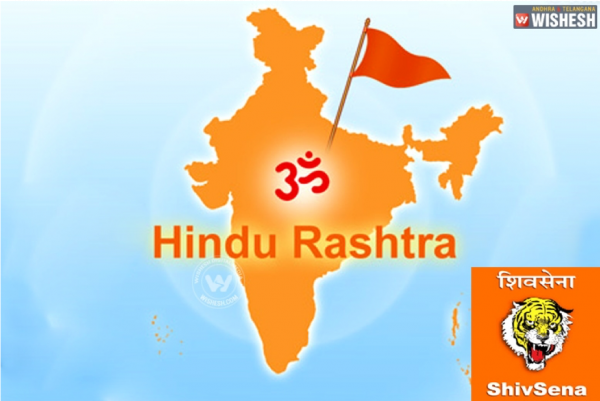
Hindu nationalists also look to the past, and, in this sense, the Hindutva claim is that Indian civilisation has always been, at its core, Hindu. The fantasy of Indian history as a tale of Hindu glory is sometimes called by its advocates the “Grand Indian Narrative.”11 By “Indian,” they mean Hindu, a vocabulary substitution that collapses Hindu and Indian into a single identity. One thread that runs through Hindutva’s vision of the future and the past is exclusion, of Muslims and of multiplicity, and I want to look at these two things in a few instances.
Hindutva advocates want to erase Muslims from the history of the Indian subcontinent, or at least efface any positive role Muslims might have had. Sometimes, they literally take Muslim rulers, like the Mughals, out of school textbooks. In 2017, Maharashtra reduced discussion of Akbar in history textbooks for classes VII and IX to a mere three lines.12 In Akbar’s place, they substituted a bigger-than-life imagination of Shivaji. The textbook’s cover shows saffron flags conquering the subcontinent—including Delhi’s Red Fort—in a remarkable display of the counterfactual.13
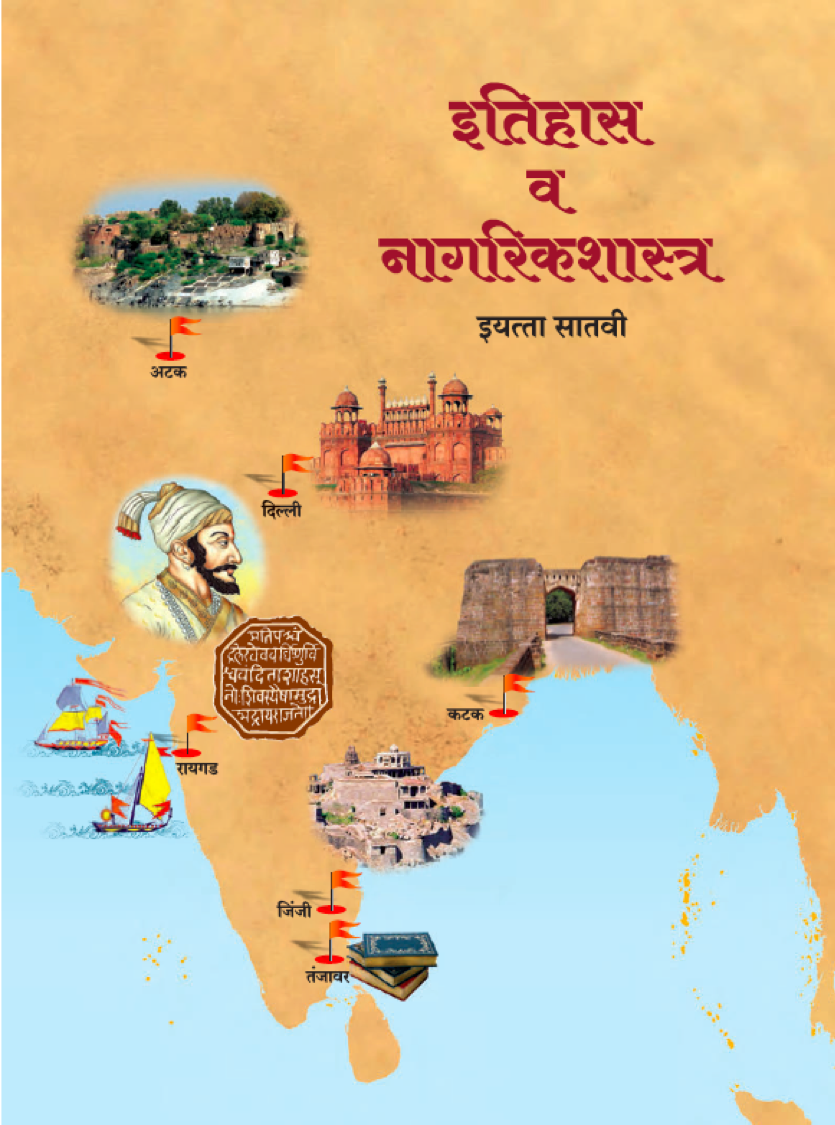
At the University level, too, the past is subject to extreme change. In 2017, Rajasthan University decided to teach a book that changed the outcome of the 1576 battle of Haldighati, claiming that Rana Pratap won the conflict, rather than Akbar, the real, historical victor14. I do not know how you narrate the rest of Indian history after you change the outcome of that conflict except to go into the realm of complete fiction, like the Rajput Empire, which never existed.
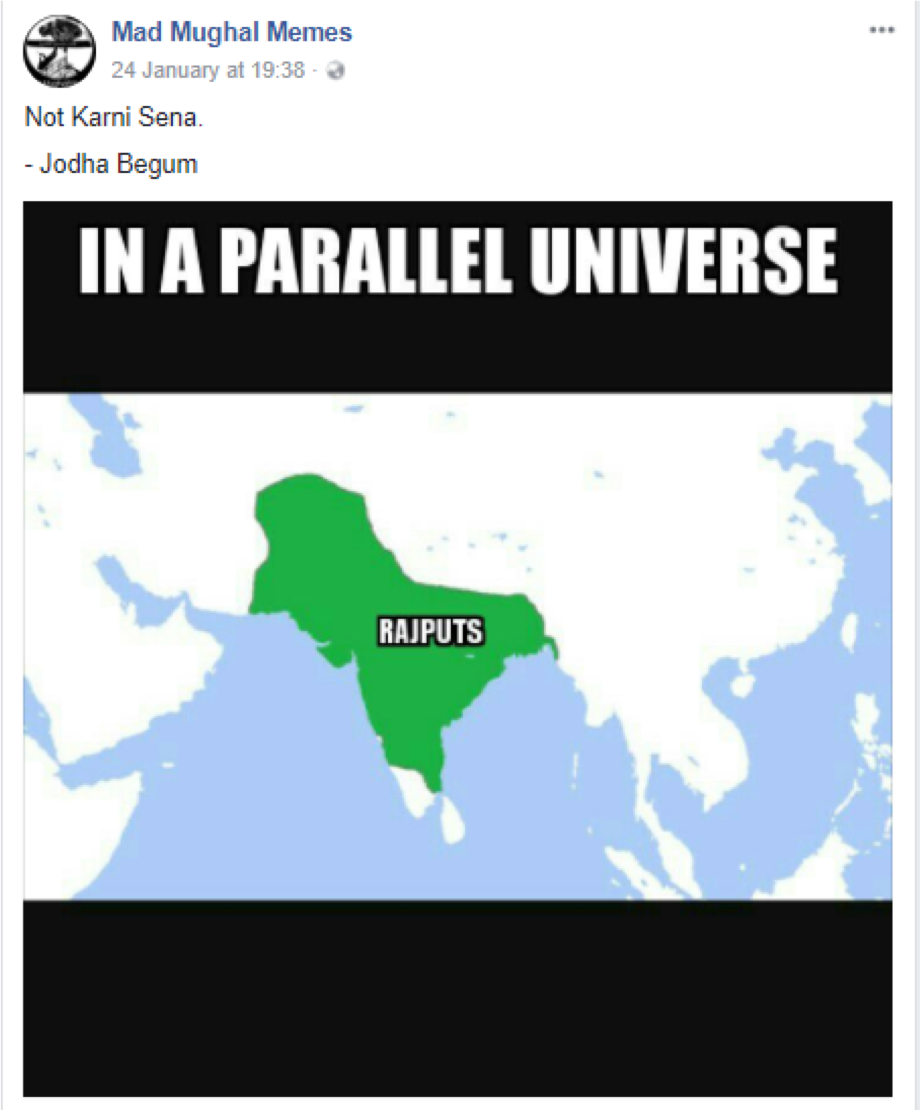
Making outlandish claims is helpful to those who advocate Hindutva, in a sense. Hindutva ideologues seek to erase Muslims from India’s past to the point of rendering history nonsensical, perhaps because then it is easier to make it up entirely. They act likewise in erasing other things as well, especially differences we can glimpse within Hindu traditions historically and over time.
Leaders in the BJP, India’s main political party and the major political branch of the Sangh Parivar, consistently make outrageous statements about the scientific achievements of ancient India. Let me give a few examples. In 2014, Prime Minister Narendra Modi said that ancient Indians practiced both cosmetic surgery and reproductive genetics15. Modi’s evidence for cosmetic surgery was Ganesha, a Hindu god who, the story goes, gained his elephant head after his father cut-off his human one and then attached the first head he found, by chance an elephant’s. For reproductive genetics, Modi cited Karna, offspring of Surya, the son god, who features in one of the Indian epics. Fast-forwarding several years, early in 2018, a BJP chief minister of a state in northeastern India said that Indians had the internet 5,000 years ago. Claims about airplanes being invented in ancient India are repeated ad nauseum these days, including at scientific forums in India.
These claims are patently absurd, quite hilariously so (I have a field day with this stuff on Twitter). More seriously though, a crucial thing that they share in common is insisting—against all logic and reason—that modern, Western science existed in ancient India. Partly this makes sense if we understand, to paraphrase Supriya Gandhi, that Hindutva yearns for its own coherence while invariably dwelling in numerous contradictions. She pointed out in a recent article that Hindutva hungers for the prestige of science while “hollowing out stellar public universities.”16 In my view, there is really nothing that demonstrates the term oxymoron more than the phrase “Hindutva History.” That said, it is particularly important and worrisome that such claims are finding their ways into academic spaces and supplanting scholarly knowledge.
Laughable claims about modern science in the wrong time and place seek to erase some of what is special or distinctive about pre-modern India, such as Hindu visions of divinity and the vast depth and sophistication of Sanskrit literature. As a Sanskritist, I take this a bit personally, I got into this field because I read the Mahabharata and marveled at its intense poetry, its traces of oral recitation, its complex use of epithets, its multiple versions, and various other aspects of this gloriously pre-modern epic. I still do that. In fact, I love the Mahabharata so much that I even read its Persian translation alongside the Sanskrit original. Here is an image of a striking manuscript in Srinagar that contains both the Sanskrit and Persian Mahabharatas at times:
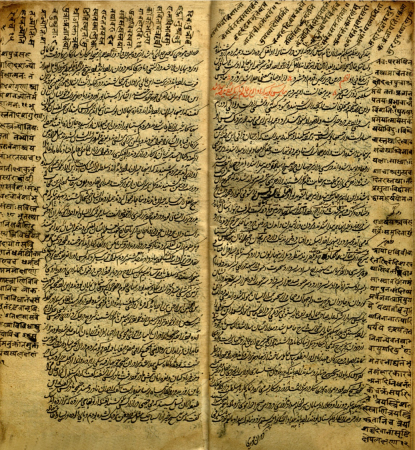
The Mahabharata is a rather unique piece of literature in many regards, which is erased when Hindutva ideologues present a mutilated version that might, if we squint hard enough, measure up to modern science.
Would Hindutva ideologues listen to anything I have to say about any of this? I sort of hope not. The last time Hindutvavadis took note of something I said regarding the Indian epics, in that case the Ramayana, I received death threats for months17. But even if they heard my views on the Mahabharata or the Grand Indian Narrative, would they consider me to have the authority to speak? The answer is no, because of who I am, or more precisely, who I am not.
From a Hindutva point of view, history is part of one’s genetic and nationalist heritage. V. D. Savarkar, the ideological godfather of Hindutva, wrote extensively about blood as a key defining feature of Hindu-ness. In his Hindutva: Who is a Hindu?, he praised the “common blood that courses through our [Hindu] veins and keeps our hearts throbbing and our affections warm.” For Savarkar, history pumps through your body, as a warm substance that gives rise to an equally warm emotional response. But things play out differently for a historian. Whereas for Hindutva proponents, knowledge of the past is in your blood and preferably emotionally hot; for academics, the modern practice of history is in your training and preferably quite calm. As a member of the latter tribe of scholars, I can never speak authoritatively or really at all on Indian history to Hindutva ideologues; I have the wrong bloodline according to them.
These days Hindutva ideologues are a bit crasser than in Savarkar’s time, but they repeat the same basic ideas. For instance, somebody told me on Twitter a few years ago: “Audrey Truschke lecturing about Indian history and culture to Indians is like a man lecturing about motherhood and labour pains to an auditorium full of mothers.” More recently, when I cited another scholar’s work , somebody responded: “Fucking bitch… You have no fucking rights to talk about my ancestor Rajendra [that would be Rajendra Chola I]…Coz you don’t know a fucking thing about him…”. This sort of vulgarity and casual misogyny is common in responses to my work or me sharing the work of others on social media. In addition to not being Indian, I am a woman and that is an identity trait which I cannot transcend in the deeply misogynist world of Hindutva, especially as constructed on social media.
Since I am excluded thrice over—as a non-Indian, as a scholar, and as a woman—from Hindutva history, oxymoron though it may be, let us now turn to my second example, which concerns affect in the built and named landscapes of Uttar Pradesh.
Affect in the Built and Named History of Uttar Pradesh
Uttar Pradesh, India’s largest state, is littered with remnants of precolonial times, in both buildings and place names. Buildings like the Taj Mahal, a Mughal tomb that dates to the seventeenth century, are India’s chief tourist attractions. Uttar Pradesh is covered with Perso-Arabic names—for cities, roads, train stations, and so forth—that read as “Muslim” to modern eyes. Certain monuments and places have become sites of intense negative emotions for some members of India’s Hindu majority. I think we can usefully understand this process by deploying Sara Ahmed’s idea of “affective stickiness” where negative feelings sort of glob onto an object, giving that object an emotional charge that can then be invoked, experienced, and even traded among people18. Affective stickiness can be a powerful unifier, bringing together even those who would not themselves take exception to a particular mosque or Perso-Arabic named place. Affective stickiness can thus serve as a formidable political weapon for those not satisfied with Uttar Pradesh’s currently diverse named and built landscape and who wish to make UP, in these regards and others, less Muslim and more Hindu.
A good example of how this affect plays out came in 2017, when Mughal Sarai Junction in UP, a busy railway junction in India, was renamed as Deen Dayal Upadhyaya Junction. The new name is so long it barely fits on the sign, but the logic is clear—sweep away a historic, Muslim name in favor of honoring a Hindutva ideologue.
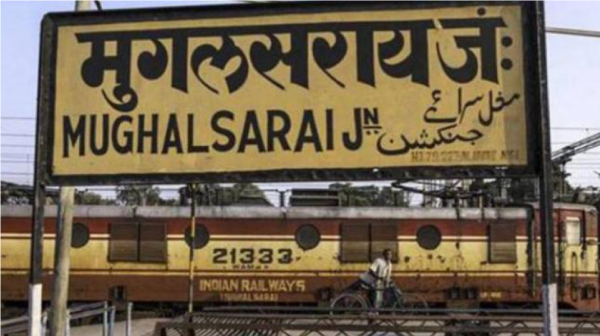

Similar is the renaming, initiated in 2018 and formalised in 2019, of Allahabad as Prayagraj. Prayagraj used to be known as Prayaga (Prayag in vernacular pronunciation), which means “confluence” in Sanskrit; it was renamed Allahabad in the late sixteenth century. Prayag-raj means “king of confluences”; it’s the bigger and better version of Prayag. Here, the government has replaced a historic, Perso-Arabic Muslim-sounding name (Allahabad) with a pseudo-Sanskrit Hindu-sounding one on steroids (Prayag-raj). Note that in both cases, pre-modern Indian history is not honored. Deen Dayal Upadhyaya is a twentieth century figure, and Prayagraj is a twenty-first century Hindutva invention. This is renaming based, not on history, but on affect.
One curious thing about Allahabad’s renaming is that its new name is not real Sanskrit. Prayagraj is Hindi; in Sanskrit would be Prayagaraja. I am not only being precise on pronunciation here (I am doing that too; once a Sanskritist, always a Sanskritist). But there is a larger context of how the BJP is increasingly attached to Sanskrit as an object, with little thought for actual Sanskrit learning and literature. What matters for Hindu populist sentiments is that something sounds like Sanskrit to people who don’t know the language. That is why, for instance, the Indian state increasingly supports teaching Sanskrit to school kids while many Sanskrit archives in India remain inaccessible to researchers.
The modern affective relationship with Sanskrit also explains why there was uproar when a scholar named Firoze Khan was appointed to the Sanskrit Department at BHU in Benares in autumn of 201919. Firoze Khan does not sound like the name of a pandit in the popular Hindu imagination. Professor Khan knew his audience. He argued to those opposing his appointment, not that he knew Sanskrit well (arguably the only thing that mattered academically-speaking), but rather that he sang bhajans to Krishna at home. Still, it did not matter because his Muslim-sounding name carried too much affective weight for his opponents. In the end, BHU appointed him to a different department. I wonder if this might have turned out differently if Firoze’s sister had been appointed as opposed to him; her name is Lakshmi.20
A potent example of affective stickiness and its negative consequences in the present is the former site of the Babri Masjid in Ayodhya. As many know, the Babri Masjid, a mosque, was built in the early sixteenth century by a general associated with Babur, who founded the Mughal Empire. The mosque existed for more than 300 hundred years without any known incident; after all, it was merely one among thousands of mosques in Hindustan. Then, in the nineteenth century, the idea arose that the Babri Masjid was located on the exact birthplace of Ram, a character in one of the Hindu epics and an incarnation of Vishnu. In 1992, after years of campaigns, the affective stickiness of the site became too much to bear, and a Hindu mob tore down the Babri Masjid, brick by brick. In the aftermath, riots swept northern India in which over 2,000 people died, mainly Muslims. The goal was to build a mandir, a Hindu temple, to Ram on the prior site of the Babri Masjid, an ambition often expressed through the slogan “mandir vahin banayenge” (the temple will be built right here).
A Hindu temple will be built on the former site of the Babri Masjid, thanks to the November 2019 Indian Supreme Court decision which is chock-full of evidence about the selective nature of affective stickiness in modern India. The Supreme Court’s Ayodhya verdict stretches to nearly 1,000 pages and is accompanied by a 100+ page concurring opinion that is even more radical21. The length of the verdict, whether by design or accident, attempts to obscure its horrific decision. The verdict concludes that a Ram temple may be built on the former site of the Babri masjid, not because of any evidence, but rather because many members of India’s dominant religion feel strongly on the point. It is an argument, essentially, about the power of majoritarian emotions.
The Ayodhya verdict signals in multiple ways that it values Hindu feelings above either Muslim feelings or evidence. For instance, the verdict mentions Hindus more often than Muslims. It employs the jaw-droppingly static category of “the Hindus” 299 times, in contrast to speaking of “the Muslims” only 174 times22. Similarly, the judgment mentions “Lord Ram” or “Bhagwan Lord Ram,” a Hindu deity, about twice as often as it mentions the Babri Masjid. The verdict contains a lengthy discussion about how “Lord Ram” is a juridical person, which is a little mind-bending for a historian since Ram is not a historical person. While great deference is given to the ahistorical, juridical person of Lord Ram, the judgment gives no indication that the Babri Masjid constituted part of the cultural heritage of all Indians. Rather, the judgment treats the Babri Masjid only as a mosque, one of many interchangeable places where Muslims might pray.
The Ayodhya verdict issued by India’s Supreme Court ends in a callous display of valuing Hindu majoritarian feelings above all else. After hundreds of pages that discuss Hindu feelings of harm and grievance that an old temple may have lain, in ruins, beneath the Babri Masjid, the verdict gives its blessing for a Hindu Temple to be built on the remains of a mosque. In so doing, the court orders a repeat of the alleged crime it condemns, namely building atop of a destroyed religious site. That the Ram Mandir will be built on the ruins of a religious structure remains perhaps the only undisputed fact about that land today.
At the heart of the Ayodhya verdict is an embrace of extrajudicial violence as an acceptable means of changing the built landscape of India. To me, one thing we might do as academics about this is to analyse and talk about it more. For those who work on space, emotion, Kashmir, or the Ramayana, the moment is now when our research can matter more than ever if we choose to ask questions that bring the relevance of our work to life outside academic walls.
The violence that brought down the Babri Masjid occurred in 1992, but over the last few months, we have seen violence, both mob-enacted and police-led, in the Indian streets. The violence has targeted Muslims, especially over the past week (late February 2020) as a horrifying pogrom took place in Delhi. Violence has also come into academic spaces as police and mobs have targeted students and faculty at several Indian universities (and it is to this, my last case study of protests and violence, that I now turn).
Violence in Academic and Protest Spaces
In December of 2019, the BJP-led Indian parliament passed the Citizenship Amendment Act, which discriminates against Muslims among those seeking Indian citizenship. I have mentioned the CAA already, but I want to underscore that, when working in tandem with the NRC especially, the effect will be to render many Muslims in India stateless. We know that the CAA and the NRC together will strip Muslims of citizenship for three reasons. We can work out the logic. Two, BJP politicians have openly said that their goal is to deprive many Muslims of Indian citizenship.23 Last, we have seen a test run of what happens in Assam in northeastern India, which has already undergone the NRC and now plans to put many Muslims in camps.24 We have a name for that sort of arrangement in English: concentration camps.
For many Indians, a nation-wide CAA and NRC proposed by the BJP went too far, and so protests began also in December of 2019. The protests have been all over India, in various cities, and have involved notably large sections of the Indian population. My favorite genre of protest signs have been these : It’s so bad that even the [fill-in-the-blank] are here.

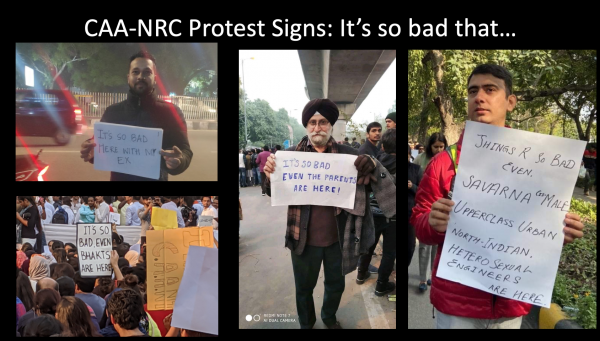
Some protests have been protected by police; some have been attacked by the police. Protests at a handful of elite universities have prompted an especially harsh response (a sign that universities still do matter, a great deal, in terms of the production of knowledge). I am interested in both the use of force and also the rhetoric that accompanies the violence. Let me walk you through some of the key events, highlighting a few things.
In mid-December of 2019, both Jamia Millia Islamia in Delhi and Aligarh Muslim University in Uttar Pradesh—two prominent, historically Muslim universities in northern India—suffered police-led attacks. In both cases, police forces entered campus and committed serious human rights violations. Separate fact-finding teams have provided timelines and accounts of both instances, and I draw on those reports here.25 Because I am relying largely on those reports I will not explicitly cover the police brutality experienced at Jamia in Delhi during the first two months of 2020, but it has been a recurrent issue.
At Jamia, in December of 2019, the police pulled students outside of a study room and then shouted "jihadi" and "deshdrohi" (terrorist) as they beat the students.26 We do not have audio but we do have CCTV footage of what happened, which you see playing27. At both Jamia and AMU, the police used "katua" (a slur for circumcised, meaning Muslims) as they physically abused students. At AMU, "aatankvaadi" (terrorist), and other derogatory terms were also employed, along with the celebratory slogans of "Bharat Mata ki Jai" and "Jai Shri Ram".28 For some, "Bharat Mata ki Jai" is a slogan of national pride and "Jai Shri Ram" a religious expression. For the police and the Hindutva mobs that they increasingly protect, these are slogans of violence against Muslims.

A few weeks later, in early January 2020, a right-wing mob descended on JNU, Delhi’s premier university, and mauled both students and faculty, putting numerous people in the hospital. Among the mob were two men, their faces masked, who, when asked why they were there, responded: “mughalon ki aulaad ko bahar nikalna hai,” “The children of the Mughals must be removed.”29 I am interested in this invocation of the Mughals, especially alongside other emphases on a Muslim identity.
For Hindu nationalists—whether among the police or in a mob, two categories that increasingly overlap—the Mughals represent everything that should not have been able to exist: a sophisticated, multicultural, complex Muslim-led polity with extensive cultural and intellectual achievements and an enduring legacy in basically all corners of South Asian life. Many will be familiar with invocations of the Mughals in the context of tearing down the Babri Masjid in the early 1990s, when “babur ki aulaad” (Babur’s progeny) was the rallying cry. In more recent years, “aurangzeb ki aulaad” (Aurangzeb’s progeny) has cropped up several times. Now the entirety of the Mughals, a stand-in for all Indian Muslims, are invoked as a justification for the physical harm enacted when a fist smashes into a face or a police lathi comes down on somebody’s back.
When I think about the violence at Jamia, AMU, and JNU—enacted by the state or with the state’s consent—I see something that, in one sense, is very old. As Upinder Singh states bluntly in her 2017 book, Political Violence in Ancient India, “Violence lies at the heart of the state.”30 I have yet to encounter a government that did not use violence to achieve its ends. But the nature and implications of that violence, especially for us today, shift radically depending on the circumstances.
I am finishing up a book project at the moment that looks, in part, at pre-modern state violence. The book is about Sanskrit histories of Indo-Muslim rule, a rich body of about 3 dozen texts that, I argue, should be read as histories. These literary histories span the entirety of Indo-Muslim rule, from the late twelfth century when the Ghurids overthrew the Chauhans to rule from Delhi until the early eighteenth century when the Mughal Empire was fracturing into pieces. Many of the earlier Sanskrit texts in the book feature cases of extreme violence, when one state decimates another and wipes it out of existence. These Sanskrit works are filled with blood, guts, and gore, the sorts of things that delighted pre-modern Sanskrit connoisseurs familiar with the rasas (aesthetic emotions) of vira (heroism), bibhatsa (the gruesome), and more. This violence was supposed to be charming, literally speaking, and it was also an expression of sovereignty. In an environment where warring was an integral part of the intertwined worlds of kingship and literature, Sanskrit authors wrote about the violence enacted by Indo-Muslim political leaders to liken them to, rather than distinguish them from, other Indian rulers. It was an integration strategy.
To come back to modernity, when a policeman or a member of a Hindutva mob yells that you are the Mughals progeny while he hits you, that man is not expressing similarity but rather unbridgeable difference. The attacker is drawing on historical memory in its worst form to Other a human being to the point that they can be savagely attacked.
For the historian, it is not entirely clear how to proceed in this environment. Many of my colleagues who live and work in India have spoken at various protests, and some have been bloodied and/or arrested for doing so. Many academics, especially outside of India, are terrified to speak-up regarding the protests or police brutality. We all have our reasons for remaining mute, mostly centering around our own needs or preferences to travel to India in the future. But the silences are heard. I think we forget sometimes, or perhaps we are simply wishful, that silence can be neutral. But it is not neutral, especially right now. In this case, we are not walking into a world where somebody else has set the cycle of silences, as Trouillot warns. In this case, we are setting the cycle of silences and thereby participating in the construction of our own moment in history.
What is a Historian to Do?
Several years ago, Harbans Mukhia, a historian of medieval India, wrote that “history is everyone’s discipline.” The statement is true in the sense that everybody cares about some past, whether it is their personal history, a family story, or a nationalist fairytale featuring founding fathers (and it is usually founding fathers, not mothers). But history is also an elite, learned enterprise, a humanities discipline. Professionally-trained historians are well-positioned to analyse Hindutva ideology, where it came from, and the various harms its proponents have unleashed upon India over the last several years. That said, scholars have had limited success going up against Hindutva claims about the past because those claims are based on affect, exclusion, and violence, rather than reasoned thought. Perhaps this is why the Indian constitution has proved an effective tool in recent protests in India against the excesses of the BJP-led state, namely that is answers affect with affect. Still, a crucial difference is that behind the affect of Hindutva lies hate, whereas behind the affect of the Indian Constitution lies reason, careful considered laws, and lofty values. It is here, in providing substance behind the scenes, that historians might prove useful in the fight against Hindutva ideology.
References
1.Rohit De, A People's Constitution: The Everyday Life of Law in the Indian Republic (Princeton: Princeton University Press, 2018), 2.
2.https://www.livemint.com/Leisure/dLi6ZIdW6CgswZCGdOA9VM/The-women-who-helped-draft-our-constitution.html
3.https://www.dailytargum.com/article/2020/02/rutgers-students-faculty-organize-protest-over-indias-citizenship-amendment-act
4.Velcheru Narayana Rao, David Shulman, and Sanjay Subrahmanyam, Symbols of Substance: Court and State in Nayaka Period Tamilnadu (Oxford: Oxford University Press, 1998).
5.https://www.livemint.com/news/india/caa-stir-bhim-army-chief-chandrashekhar-azad-arrested-say-delhi-police-11576921812949.html
6.https://www.indiatoday.in/india/story/anti-caa-protest-court-directs-urgent-medical-treatment-jailed-bhim-army-chief-chandrashekhar-azad-1635104-2020-01-08
7.Dipesh Chakrabarty, The Calling of History: Sir Jadunath Sarkar and His Empire of Truth (Chicago: University of Chicago Press, 2015). I gave this talk in the Richard Ettinghausen Library at NYU’s Kevorkian Center.
8.Michel-Rolph Trouillot, Silencing the Past: Power and the Production of History (Boston: Beacon Press, 1995), 26.
9.Sumit Guha, History and Collective Memory in South Asia, 1200–2000 (Seattle: University of Washington Press, 2019), 178.
10.Sanjib Baruah, “‘Ethnic’ Conflict as State–Society Struggle: Poetics and Politics of Assamese Micro-Nationalism,” Modern Asian Studies 28:3 (1994): 653.
11.https://www.pgurus.com/rajiv-malhotra-on-the-grand-indian-narrative-at-mumbai-on-jul-8-2018-function-hosted-by-virat-hindustan-sangam-maharashtra/
12.https://www.firstpost.com/living/maharashtra-textbooks-erasure-of-mughals-history-is-being-held-hostage-by-politics-3924013.html
13.https://thewire.in/history/maharashtra-education-board-removes-traces-mughals-history-textbooks
14.https://thewire.in/education/rajasthan-university-maharana-pratap-akbar-history
15.https://www.theguardian.com/world/2014/oct/28/indian-prime-minister-genetic-science-existed-ancient-times
16.https://indianexpress.com/article/opinion/columns/bhu-sanskrit-teacher-appointment-a-mughal-prince-and-the-pandits-of-benares-6151011/
17.https://thewire.in/religion/the-many-criticisms-of-rama-and-the-anger-of-the-hindu-right
18.Sara Ahmed, The Culture Politics of Emotion, 2nd edition (Edinburgh: Edinburgh University Press, 2014).
19.https://www.bbc.com/news/world-asia-india-50557616
20.https://gulfnews.com/world/asia/india/bhu-sanskrit-professor-row-who-is-feroz-khan-1.67956439
21.https://www.sci.gov.in/pdf/JUD_2.pdf
22.https://caravanmagazine.in/religion/ayodhya-babri-masjid-ram-mandir-supreme-court-audrey-truschke
23.https://twitter.com/amitshah/status/1120275890871521280?lang=en
24.https://www.vox.com/future-perfect/2019/9/17/20861427/india-assam-citizenship-muslim-detention-camps
25.https://indianculturalforum.in/2019/12/24/the-siege-of-aligarh-muslim-university-a-fact-finding-report/;
https://pudr.org/sites/default/files/2019-12/Jamia%20Report%202019%20for%20screen.pdf
26.https://pudr.org/sites/default/files/2019-12/Jamia%20Report%202019%20for%20screen.pdf
27.I played the footage as I spoke.
28.https://www.newsclick.in/Siege-Aligarh-Muslim-University-Fact-Finding-Report
29.https://twitter.com/RanaAyyub/status/1213861998427090944?s=20
30.Upinder Singh, Political Violence in Ancient India (Cambridge: Harvard University Press, 2017), 10.




